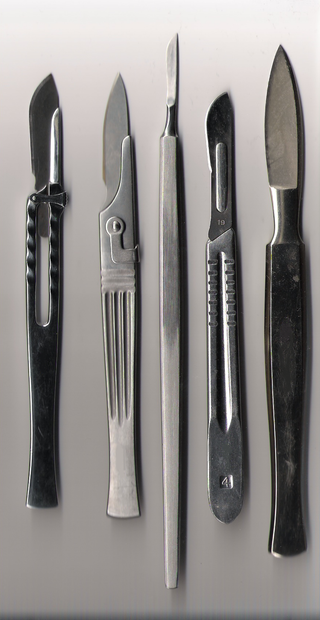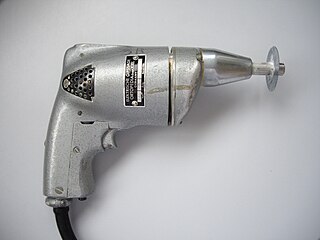
Scissors are hand-operated shearing tools. A pair of scissors consists of a pair of metal blades pivoted so that the sharpened edges slide against each other when the handles (bows) opposite to the pivot are closed. Scissors are used for cutting various thin materials, such as paper, cardboard, metal foil, cloth, rope, and wire. A large variety of scissors and shears all exist for specialized purposes. Hair-cutting shears and kitchen shears are functionally equivalent to scissors, but the larger implements tend to be called shears. Hair-cutting shears have specific blade angles ideal for cutting hair. Using the incorrect type of scissors to cut hair will result in increased damage or split ends, or both, by breaking the hair. Kitchen shears, also known as kitchen scissors, are intended for cutting and trimming foods such as meats.

An ingrown nail, also known as onychocryptosis from Greek: ὄνυξ 'nail' and κρυπτός 'hidden', is a common form of nail disease. It is an often painful condition in which the nail grows so that it cuts into one or both sides of the paronychium or nail bed. While ingrown nails can occur in the nails of both the hands and the feet, they occur most commonly with the toenails, and for the most part are only problematic and painful on the big toe.

A surgical instrument is a tool or device for performing specific actions or carrying out desired effects during a surgery or operation, such as modifying biological tissue, or to provide access for viewing it. Over time, many different kinds of surgical instruments and tools have been invented. Some surgical instruments are designed for general use in all sorts of surgeries, while others are designed for only certain specialties or specific procedures.

A kitchen knife is any knife that is intended to be used in food preparation. While much of this work can be accomplished with a few general-purpose knives – notably a large chef's knife, a tough cleaver, a small paring knife and some sort of serrated blade – there are also many specialized knives that are designed for specific tasks. Kitchen knives can be made from several different materials.
A bolt cutter, sometimes called bolt cropper, is a tool used for cutting bolts, chains, padlocks, rebar and wire mesh. It typically has long handles and short blades, with compound hinges to maximize leverage and cutting force. A typical bolt cutter yields 20 kilonewtons (4,500 lbf) of cutting force for a 250 newtons (56 lbf) force on the handles.
A wedge is a triangular shaped tool, and is a portable inclined plane, and one of the six simple machines. It can be used to separate two objects or portions of an object, lift up an object, or hold an object in place. It functions by converting a force applied to its blunt end into forces perpendicular (normal) to its inclined surfaces. The mechanical advantage of a wedge is given by the ratio of the length of its slope to its width. Although a short wedge with a wide angle may do a job faster, it requires more force than a long wedge with a narrow angle.

Sharpening is the process of creating or refining the edge joining two non-coplanar faces into a converging apex, thereby creating an edge of appropriate shape on a tool or implement designed for cutting. Sharpening is done by removing material on an implement with an abrasive substance harder than the material of the implement, followed sometimes by processes to polish/hone the sharp surface to increase smoothness.

Bondage tape is a 2-to-3-inch-wide and 0.0051 in-thick (0.13-millimetre) strip of thin plastic material that adheres only to itself, without any adhesive; it is typically intended to be used in erotic bondage. Since it does not stick to the hair or skin, a bottom can be tightly bound or gagged without causing harm when the tape is removed.

Trauma shears, also known as Tuff Cuts, are a type of scissors used by paramedics and other emergency medical personnel to quickly and safely cut clothing from injured people. They usually consist of a plastic handle with a metal blade, which is traditionally bent at about 150 degrees, giving them an unusual appearance as compared to normal scissors, and also a longer "lever arm".
Snips, also known as shears, are hand tools used to cut sheet metal and other tough webs. It is a cutting tool. Workers use various types of snips, either straight or blend one be obtained. The straight or bent being not only for straight cuts but for inside of the curvature or concave curvature too. There are two broad categories: tinner's snips, which are similar to common scissors, and compound-action snips, which use a compound leverage handle system to increase the mechanical advantage.

Pruning shears, also called hand pruners, or secateurs, are a type of scissors for use on plants. They are strong enough to prune hard branches of trees and shrubs, sometimes up to two centimetres thick. They are used in gardening, arboriculture, plant nursery works, farming, flower arranging, and nature conservation, where fine-scale habitat management is required.

Metzenbaum scissors are surgical scissors designed for cutting delicate tissue and blunt dissection. The scissors come in variable lengths and have a relatively long shank-to-blade ratio. They are constructed of stainless steel and may have tungsten carbide cutting surface inserts. The blades can be curved or straight, and the tips are usually blunt. This is the most common type of scissors used in organ-related operations.
Hairstyling tools may include hair irons, hair dryers, hairbrushes, hair rollers, diffusers and various types of scissors.
There are many types of shears used to shear or cut sheet metal.
Surgical scissors are scissors specially manufactured as surgical instruments, typically used for cutting sutures, dressings, and cutting and dissecting biological tissue. Surgical scissors are usually made of surgical steel. Some have tungsten carbide reinforcements along their cutting edges, the hardness of which allows manufacturers to create sharper and more durable edges.

Mayo scissors are a type of surgical scissor, often used in the cutting of fascia.

A regular haircut, in Western fashion, is a men's and boys' hairstyle that has hair long enough to comb on top, a defined or deconstructed side part, and a short, semi-short, medium, long, or extra long back and sides. The style is also known by other names including taper cut, regular taper cut, side-part and standard haircut; as well as short back and sides, business-man cut and professional cut, subject to varying national, regional, and local interpretations of the specific taper for the back and sides.

Blade shearing or hand shearing is the style of shearing sheep and other animals with fibrous coats with a set of specialized scissors. It is practiced in many parts of the world as both an occupation and a sport. Commercial blade shearers shear on average 140 sheep in an 8-hour working day, but some will shear over 200 sheep in a day.

A cast saw is an oscillating power tool used to remove orthopedic casts. Unlike a circular saw with a rotating blade, a cast saw uses a sharp, small-toothed blade rapidly oscillating or vibrating back and forth over a very small angle to cut material. This device is often used with a cast spreader.













